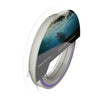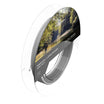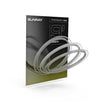
Austrian grayling taken on a size 24 cdc midge
It never ceases to amaze me how few flyfishers use small flies, most anglers considering size 16 seems to be small. Whilst in the USA tiny Midge patterns have been popular for many years elsewhere they seem to be largely ignored. Yet I regularly find that I need Micro-flies not only in the UK but also on my travels abroad. Most anglers who see me fishing size 26 Buzzers, 30 CdC Midges & the like respond by saying “I can’t see such small flies”, “Surely the fish can’t see such tiny flies!”, “I can’t tie such small flies onto my tippet”, “I could never tie such tiny flies”. All I can say is that I’m 67 years old & wear glasses & have no problems tying, tying on, or seeing my micro-dry flies (at the short range that I prefer to fish).

Midge pupa taken from a trout’s stomach & size 24 Midge Pupa imitation
In the UK trout & particularly grayling often get fixated on tiny insects when they are abundant, Aphids in spring & again at leaf fall, Midges throughout the year, Thrips/Thunderbugs at harvest time on lowland rivers, Reed Smuts/Black Flies in summer, Caenis spinners early on summer mornings or late in the evening & Agapetus Caddis pupae during emergence (I’ll be talking about Agapetus later in the year): all of these are 5mm or smaller (size 20 to 30 hook).
In New Zealand summers Willow Grubs (tiny yellowish Sawfly larvae) have saved my fishing (I’ll tell you more about them in a later blog). One cold day on Slovenia’s Unica river in September 2015 a size 26 to 20 CdC IOBO Humpy accounted for about 60 grayling up to 45cm when they were rising first to Micro-Midges & then to tiny Olives. In the high alpine lakes of Austria I’ve had to fish size 24 & smaller Midges, on several occasions, in order to tempt preoccupied, brown trout, brook trout & grayling, whilst on the rivers of Yellowstone National Park in Wyoming I’ve sometimes needed size 20 & smaller CdC dry flies to tempt fussy cutthroats feeding on tiny Ants, Midges & Tricos.
The patterns I tie are all very simple, but effective. Jack Tucker’s IOBO Humpy in size 20 to 24 is a superb Aphid/Midge/Smut imitation (I tie mine with 2 CdC feathers & a different tying sequence than the original). Sub 24 I tie my Minimalistic Micro-Midge, just a tuft of CdC tied onto a short shank hook. A size 20 Griffiths Gnat is another great fly: it can be very effective when dragged just enough to create a wake during heavy falls of Caenis spinners when there are so many naturals on the water that fishing a drag-free fly is ineffective. I mentioned size 20 to 26 Micro Bead-Head Buzzers in my Micro flies Blog: they’ve accounted for many of my still water rainbows & some very big grayling.

Whatever tiny fly you choose to fish with, good presentation is the biggest challenge. They have very little surface area or inertia with which to resist micro-drag generated by aberrant currents acting on the tippet. The two key ways to limit this are firstly to use the finest, most supple tippet that is practical & the second is to tie the fly into a loop knot (Rapala knot or Perfection Loop) so that it is not rigidly attached to the tippet. Long, light line rods help not only with line control but reduce the risk of tippet breakage.

Size 20 Agapetus pupa tied into a loop knot
A further challenge is accuracy. Fish will usually not move more far for such tiny morsels. This is particularly true of grayling, which are very efficient feeders. You’ll need to be pinpoint accurate with your casting so ideally you’ll need to be targeting risers or visible subsurface fish. Since I learned the Italian Style of Casting it has dramatically improved my accuracy when fishing dry flies, particularly on windy days. (In a later blog post I’ll tell you all about Massimo Magliocco & the Italian Casting Style that is very different from conventional casting & that confers many advantages other than accuracy).
So if you’ve never fished with a fly smaller than size 18 give them a try. Keep the patterns simple & use a magnifying lamp & they’re not difficult to tie. If you aren’t a fly tier then more & more suppliers are offering small flies in their ranges. If you have difficulty threading the line through the eyes tie on Orvis Big Eye dry fly hooks or Daiichi 1110s (identical to the Orvis hooks). As for seeing tiny dry flies on the surface, fish at close range or even use hi-vis materials (the fish will take fluoro-pink CdC Midges). As for the fish they have no trouble seeing micro-flies.

Unica grayling taken on size 24 CdC dry fly
































